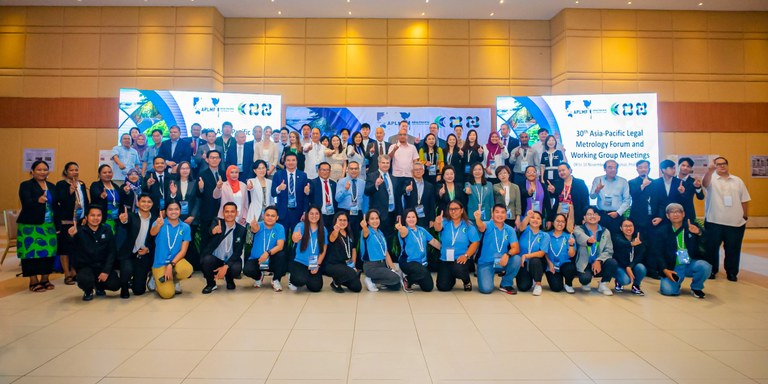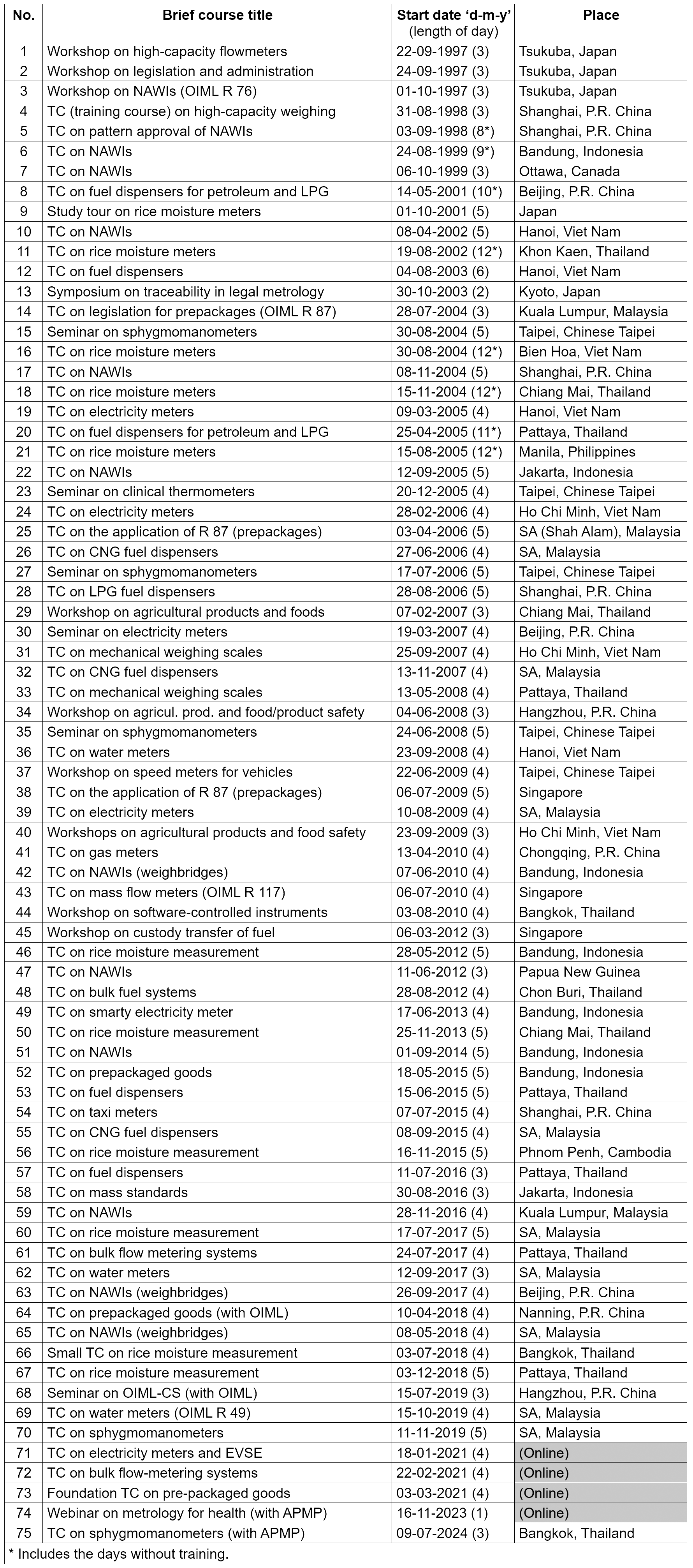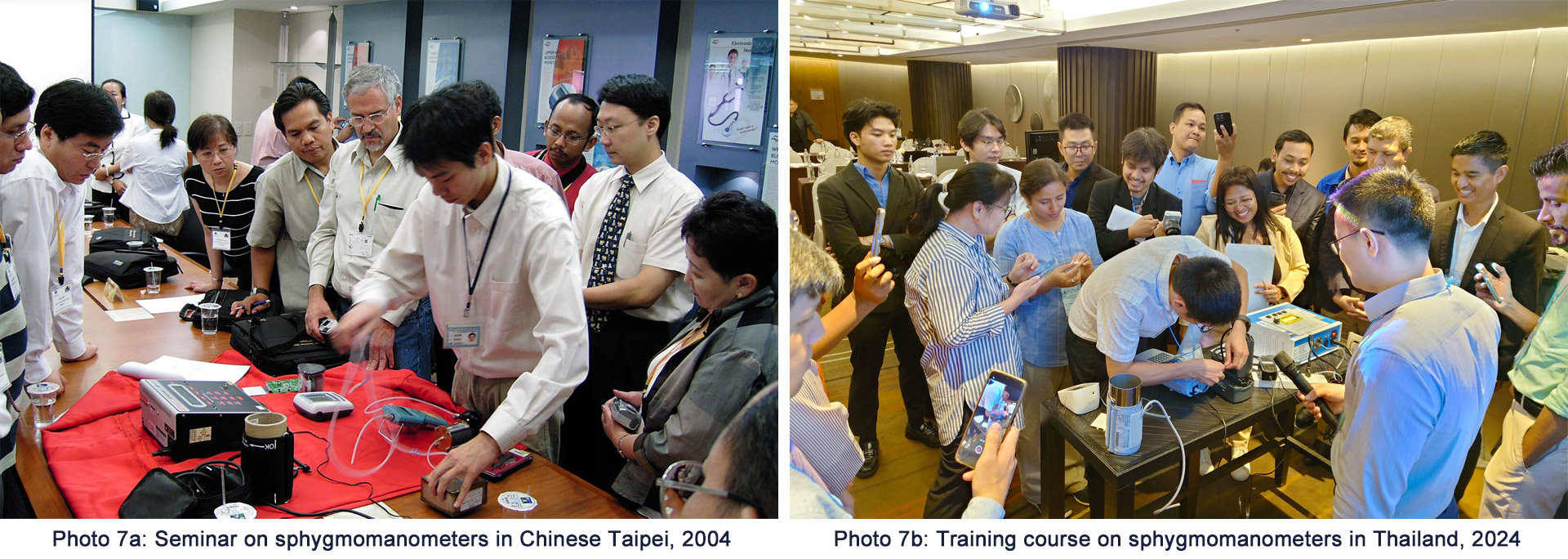OIML BULLETIN - VOLUME LXV - NUMBER 3 - JULY 2024
e v o l u t i o n s
Legal metrology systems in the Asia-Pacific region

Tsuyoshi Matsumoto
Training Coordinator of APLMF, Japan
1 Introduction
This article provides a comprehensive overview of the legal metrology systems in the Asia-Pacific region from the author's personal viewpoint through the APLMF*, one of the RLMOs* that collaborates closely with the OIML*.
* See section 7 for the abbreviations.
1.1 Legal metrology system
The social system for metrology, an integral part of human life, has existed throughout history. In this framework, legal metrology forms an indispensable national infrastructure for security, trade, commerce, and consumer protection in many countries. The roots of this system are found in the ancient civilizations more than 5000 years ago. In Eastern Asia, an earlier system of measurement units was found during the Qin Dynasty in P.R. China in 221 BC. In Japan, a preliminary form of law on metrology was found in the Taiho Code enforced in 701 AD.
The modern scientific framework for measurement units/standards began with the Metre Convention in 1875. From the early 20th century, the Meter Convention recognized the need for a dedicated committee to respond to the needs of society regarding legal and/or practical measurements, including the control of measuring instruments. This recognition led to the establishment of the OIML in 1955, marking the beginning of the modern international framework for legal metrology. The OIML, in its role, supports the global framework for quality infrastructures in cooperation with other international organizations and emphasizes collective effort for conformance in the field of legal metrology. The significance of legal metrology with its perspective for the future was already mentioned in the articles [1] and [2].
1.2 Asia-Pacific region
The term ‘Asia-Pacific’ is generally considered to indicate a region surrounding the Pacific Ocean. However, the region is not precisely defined, and its boundaries vary slightly according to the context of using this term. It is generally composed of Northeastern Asia, Southeastern Asia, Oceania, the Pacific Islands, and North & South America. Referring to the APLMF member economies (Figure 1), this region has a total population of 2.8 billion, which covers 35 % of the entire world.

Figure 1: Geographical view of the APLMF member economies
During its long history, many countries and civilizations existed in this region. They may be categorized into (1) Western and Latin countries, several of which have historical roots and cultural ties to Europe, (2) Eastern Asian countries with a common cultural background, (3) Southeastern Asian countries, and (4) Pacific Islands. Due to such a variety in the region, there is significant diversity in culture, language, religion, lifestyle, and way of thinking. The diversity also applies to the history and the social infrastructure in metrology in each country.
2 Outline of the APLMF (Asia-Pacific Legal Metrology Forum)
2.1 Brief history
When the Asia-Pacific Economic Cooperation (APEC) was established in 1989, a new regional community for legal metrology was requested. It was intended to support APEC’s important objective of realizing sustainable economic development in the region through the exchange of goods and technology based on compliance with global standards. Compliance with the Agreement on Technical Barriers to Trade (TBT) has been an important objective of the World Trade Organization (WTO), which is a similar organization at the global level established in 1995 to promote open and multilateral trade.
To respond to such needs, the inaugural meeting of the APLMF was held in 1994 in Sydney with the legal metrology authorities from the fourteen APEC economies. Membership has since been extended to twenty-one Full Members and two Corresponding Members (Table 1).
Considering the diversity in the region, this forum was designed to be a community for cooperation and information exchange without strictly enforced requirements of the members. For this reason, some members also participate in other RLMOs.
The APLMF President and Secretariat typically come from the same economy. NSC (National Standards Commission) of Australia, which was later reformed as NMIA, initially took over these roles, which were subsequently handed over to Japan (NMIJ) in 2002, P.R. China (SAMR at present) in 2007, New Zealand (MBIE) in 2015, and Malaysia (NMIM) in 2021. Since its establishment, an APLMF Forum Meeting has been held every year. In 2020–2022, however, the meetings had to be held online due to the COVID-19 pandemic. The 30th forum meeting in 2023 was held in-person in the Philippines (Photo 1).

Photo 1: 30th APLMF Forum Meeting in the Philippines, 2023
2.2 APLMF member economies
APLMF member countries are always referred to as ‘economies’ following the practice of the APEC. The member economies are shown graphically in Figure 1 and listed in Table 1, including their populations, areas, LMAs, NMIs, and status of participation in the international organizations. Chile, Colombia, DPR Korea, and Mexico previously joined as members, though they are not shown. At the 30th Forum Meeting in 2023, the PIMC was approved to be the first Observer. This committee, which was established in 2023 with the 18 economies of the Pacific Islands, actively conducts a development project in metrology to support the quality infrastructure in the islands.
Table 1: APLMF Member Economies

2.3 APLMF Working Groups
There are eight Working Groups (WGs) of experts in the APLMF, each responsible for a specific area of legal metrology and the practical implementations of technical work, survey studies on various legal metrology topics, and training. Table 2 shows the names, economies responsible for the chair, covered fields, and brief histories of the WGs. Several members/experts from other member economies support each WG.
Table 2: APLMF Working Groups (WGs)

2.4 Information on the APLMF website
The materials submitted to the recent Forum Meetings are shared on the APLMF website [4]. This includes economy reports, which are utilized as valuable sources of information about the current situation concerning legal metrology in the member economies. In 2003, the APLMF Directory, which introduced outlines of the legal metrology systems in the member economies, was published. Its contents were updated and uploaded on the APLMF website in the late 2010s [4]. This website also shares materials used for training and guidance documents for some categories of measurement [4].
2.5 Liaison organizations
The APLMF has a close liaison with the OIML through its CIML, TCs/SCs, RLMO RT, CEEMS AG, and DTG. Some member economies have assumed key roles in the OIML. It also has liaisons with APEC through the SRB Forum which is composed of the four regional organizations for standardization and conformance. The cooperation with the APMP has been enhanced through the MEDEA project (3.2). In the ASEAN, the APLMF has a liaison with WG3 on legal metrology under the Consultative Committee for Standards and Quality (ACCSQ).
3 APLMF training activities
3.1 Outline
The APLMF has focused on training activities since its establishment to support the development of the social infrastructures in legal metrology in the member economies. This role has been provided through training courses, seminars, and workshops conducted in a specific field of metrology. The training program started in 1997, and over 1 500 participants joined over 70 events. A complete list of all training programs is given in Table 3. Training plans are developed and prioritized based on the survey results among the member economies. Trainers and materials are provided by the responsible WG as well as the member economies.
The former Working Group on Training Coordination had long been responsible for training coordination. After it was disbanded in 2017, its role was transferred to that of Training Coordinator, a member of the Secretariat. NMIA, Australia took this responsibility for a long time with the coordinators, Mrs Kerry Marston (1996–2000) and Mrs Marian Haire (2001–2021).
Table 3: APLMF Training Courses (TCs) / Seminars / Workshops

3.2 Support for training
Training activities are supported using the APLMF membership fees and voluntary contributions from the member economies. In addition, from 2001 to 2012, the APLMF sought and utilised the APEC-TILF (Trade and Investment Liberalization and Facilitation) fund. Since 2014, the PTB in Germany has supported APLMF training activities through the MEDEA project. This project targets the developing economies of the APLMF and the APMP in South-West Asia. In 2021, the third-phase project (MEDEA 3) was continued for four years. One remarkable outcome of this project is the synergy with the APMP on scientific metrology. The APMP-APLMF Web Portal [5] has been created for sharing information and raising awareness in metrology.
3.3 e-Learning materials
During the pandemic, developing e-Learning materials (or modules) has become an important factor in training activities. An e-Learning module is normally a set of digital learning materials (e.g., slides, documents, videos, animations, and sample questions). The trainers use this module in online training courses, and it may be permanently provided on an online learning platform for self-learning by the participants. The APLMF WGs are drafting e-Learning materials and/or modules following the APLMF Guide 8: How to Develop an eLearning Module [4]. The two modules for fuel dispensers and NAWIs have been completed and utilized by the member economies since 2021. The current movement from physical to online training with the use of e-Learning will likely continue in the future, even after the pandemic.
4 Common topics in the Asia-Pacific region
4.1 Mass measurement
Mass measurement is the most fundamental field in legal metrology. OIML R 76:2006 Non-automatic weighing instruments and its former editions have been introduced as a technical standard in many member economies. National or regional technical standards are largely compliant with this Recommendation. In addition, practical verification procedures, particularly for weighbridges and spring scales, have been requested in this region.
Some economies include automatic weighing instruments (AWIs) in legal metrological systems, and these instruments are closely related to the prepackages they produce. R 51:2006 Automatic catchweighing instruments and R 61:2017 Automatic gravimetric filling instruments are the two common categories of AWI. Some economies also have concerns about R 50, R 107 and R 134.
The APLMF has conducted many training courses in this field since 1997 (Photo 2). The WG on Weighing Instruments in Malaysia coordinates training activities and e-Learning materials in this field.

4.2 Measurement of fuel
The volumetric measurement of fuel is also an important category in legal metrology. Fuel dispensers for liquid petroleum and LPG (liquefied petroleum gas) for motor vehicles are the typical measuring instruments under metrological control. OIML R 117:2019 Dynamic measuring systems for liquids other than water and its former editions are used as the technical standard.
Some economies, such as Malaysia and the USA, utilize CNG (compressed natural gas) and LNG (liquefied natural gas) for vehicles and have made efforts to standardize and verify the metrological qualities of dispensers for compressed gas. Use of hydrogen as an alternative energy source has been increasing gradually over the past several years, and member economies have begun devoting attention to the practical application of OIML R 139:2018 Compressed gaseous fuel measuring systems for vehicles. Custody transfer of liquid petroleum for business-to-business transactions is controlled under legal metrology in some economies, and a reliable bulk flow metering system is requested.
The APLMF has conducted many training courses on fuel dispensers for petroleum, LPG, and CNG, as well as bulk flow metering systems (Photo 3). The coordination of these activities, which was previously a responsibility held by the Training Coordinators, is now conducted by the new WG on Measurement of Fuels in Australia.

Photo 3: A training course on fuel dispensers in Thailand (2015)
4.3 Utility meters
Utility meters are measuring instruments used in households and businesses to measure consumption of water, gas, and electricity. In many member economies, water and gas meters are controlled by the local authorities or suppliers under the supervision of the LMA. OIML Recommendations R 49:2013 Water meters for cold potable water and hot water and R 137:2012 Gas meters are introduced in many economies. The APLMF has conducted training courses on utility meters (Photo 4). The WG on Utility Meters in P.R. China coordinates training activities.
The scheme of metrological control on electricity meters is sometimes different, in large part due to the requisite technical expertise and the historical structure of the market. A ministry/agency responsible for energy, independent of the LMA/NMI, sometimes supervises such meters in cooperation with the electricity suppliers. OIML R 46:2012 Active electrical energy meters is utilized in this region. NMIA, Australia coordinates the OIML projects on electricity meters including EVSE, under the TC 12.
The increasing use of smart meters with a communication function is a common topic in electricity metering, and there is a high level of concern about the software used for metering and transferring data. Another recent concern for electricity metering focuses on the charging systems used for electric vehicles, also known as electric vehicle supply equipment (EVSE). In some economies, such as P.R. China, the use of electric vehicles is increasing rapidly, and metrological control of the DC metering systems for EVSE is an important issue for regulatory authorities.

Photo 4: A training course on water meters in Malaysia (2019)
4.4 Prepackaged goods
Control of prepackages is an important role of LMAs to protect consumers, and the control or inspection system for such products has a long history in many countries/economies.
In this region, New Zealand and Indonesia have supported the implementation of OIML R 87:2016 Quantity of product in prepackages and its former editions, and they have led training courses and promotional activities on the importance of this topic. The Guide G 21:2017 Guidance for defining the requirements for a certification system for prepackages is also taken into consideration. Many economies have concerns about the practical implementation of market surveillance on prepackages. Indonesia recently provided an article [6] introducing the increasing trade of prepackages and the need for a consistent global control system.
However, there is still considerable diversity in approaches to this topic among the member economies. In general, an economy with a long history maintains its own control system, including a minimum quantity system, but broad harmonization with the average quantity system represented by the R 87 has not yet been realized.
The APLMF conducted many training courses on prepackages (Photo 5). The WG on Goods Packed by Measure in Indonesia coordinates training activities, e-Learning materials, and surveys on prepackages.

4.5 Quality measurement of agricultural products
The quality of agricultural products, particularly moisture content, is a critical factor for fair trade. Regarding moisture content, because grain samples are unstable in characteristics, a local authority should conduct a reference method using an oven to maintain regional traceability.
In some Southeast Asian economies with grain productions, moisture meters are controlled by legal metrology regulations to protect farmers, traders, and consumers through periodical verification or inspection. Some economies are setting up a local type-approval system based on OIML R 59:2016 Moisture meters for cereal grains and oilseeds. Separation of duties between multiple government ministries to enforce requirements for measurement traceability, field verification, and type approval of devices used in agriculture is sometimes seen, e.g., between the Ministry of Economy and the Ministry of Agriculture. However, some economies attempt to maintain cooperation among these entities.
The APLMF has conducted many training courses and workshops on agricultural measurement (Photo 6). The WG on Quality Measurement of Agricultural Products in Malaysia coordinates training activities and e-Learning materials. This WG also published the APLMF Guide Document on Rice Moisture Measurement in 2017 [4].

4.6 Medical measurement
Clinical thermometers and sphygmomanometers are two categories of medical devices that often fall within the realm of legal metrology. In medical measurements, dual control by two separate government sectors, one for legal metrology and one for health/medicine, sometimes occurs. The former usually controls the medical devices as measuring instruments for temperature and pressure. The latter controls the devices to be allowed for practical medical applications. OIML R 114 and R 115 for clinical electrical thermometers and R 148 and R 149 for non-invasive sphygmomanometers are applied to type approvals.
The APLMF conducted seminars and training courses on medical measurement by the former WG on Medical Measurement chaired by Chinese Taipei. This role has been transferred to P.R. China, and the renewed WG coordinates training activities and surveys to assess the current situation in the member economies (Photo 7).

4.7 Type evaluation and the OIML-CS
Many measuring instruments are produced and exported in this region, particularly in P.R. China, Japan, Rep. Korea, and the USA. This led to recognition of the importance of mutual acceptance of type evaluation of these devices. Table 1 shows the participation status in the OIML-CS. There are three OIML Issuing Authorities, seven Utilizers, and two Associates. The WG on the OIML-CS in P.R. China is responsible for liaising with the OIML-CS and providing seminars and e-Learning materials to raise awareness of this system.
Many economies implement national/regional type-approval systems, and some have testing laboratories. In many cases, applicable OIML Recommendations are utilized as local technical standards. An OIML certificate issued by an OIML Issuing Authority abroad is normally accepted by a member economy. However, the acceptance is sometimes voluntary and depends on the specific procedure in each economy. The WG encourages more member economies to participate in the OIML-CS to facilitate mutual acceptance of the certificates.
4.8 Project for conformity to type (CTT)
There is concern regarding conformity to type (CTT), particularly in the economies that import measuring instruments. These economies have found unfavourable cases where imported instruments did not meet the predetermined performance on the OIML certificate/test report. New Zealand serves as the secretariat of OIML TC 3/SC 6 and has supported the OIML D 34:2019 CTT - Pre-market conformity assessment of measuring instruments. In 2018, NMIA, Australia proposed a pilot project for pre-market surveillance on CTT, in which a measuring instrument is purchased in the market and tested by an LMA/NMI.
4.9 Verification with a uniform test procedure
Verification of measuring instruments has been a significant concern in the APLMF, and many training courses have covered this topic. Regarding the initial verification, many economies are introducing testing by authorized manufacturers. Some of them are devising a scheme whereby government delegations are assigned to private institutes/laboratories to conduct periodical verifications. In Japan and some other economies, certified measurers are authorized by the government to facilitate verifications.
Uniform test procedures for verification, which are not fully covered by the respective OIML Recommendations, have been requested in this region. The APLMF conducted surveys from 2015 to 2020 to investigate the procedures employed in each economy. The outcomes of these surveys are shared on the website as Guide Test Procedures [4]. The results are being used to provide information on the development of e-Learning materials and guide documents.
Economies, particularly with low population density, often have difficulty conducting periodical verifications and maintaining trained verifiers. Some of them employ risk-based sampling inspections. P.R. China proposed remote testing methods using digital technology [7], which could be an effective solution in the new era of DX.
4.10 Digital transformation (DX) and the software used for measurement
Digital transformation in metrology has become a big movement in the metrology organizations. In the APLMF, a new Sub-Working Group (SWG) on Digitalization in Metrology was set up in 2023 under the WG on Metrological Control Systems. This SWG is responsible for digitalization in legal metrology. Software for measuring instruments is an important subject of this SWG because there has been a strong need for certification to protect consumers from unauthorized transactions. Liaison with the OIML DTG and OIML TC 5/SC 2 , as well as other metrology organizations, is an important role of the SWG.
4.11 Cooperation with the RLMO RT and the CEEMS AG
The utilization of e-Learning modules/materials is an important topic of the OIML RLMO RT. In its meetings, the APLMF has encouraged OIML member countries to provide their materials voluntarily. The APLMF also continues to discuss sharing its e-Learning materials for the benefit of OIML member countries.
At the 58th CIML Meeting in 2023, the CEEMS AG proposed a work program, entitled “NEXT LMS”, which Thailand had developed as the ‘Chiang Mai Declaration’ [8]. This program aims to strengthen the legal metrology systems of the CEEMS countries by providing a framework for utilizing the expertise of the OIML member countries. This program will also be coordinated with APLMF activities.
5 Conclusions
It should be noted that the common topics mentioned above might be similar to those in other regions. The author hopes that this article will be informative to all OIML member countries and that it will aid in promoting regional cooperation, especially among the economies where there might be significant differences in legal metrology systems.
Recent digital communication technology has lowered the barriers between countries and regions, and people can meet online at virtually any time. As a positive outcome of this newly common practice, global cooperation among the legal metrology community is expected to accelerate in the future.
6 References
- John Birch A.M., International Organization of Legal Metrology (OIML), OIML E 2:2003: Report: Benefit of Legal Metrology for the Economy and Society.
- Akira Ooiwa, International Organization of Legal Metrology (OIML), OIML Bulletin Vol. XLIV No. 2, April 2003, pp. 20-23: Desirable legal metrology framework for the APLMF.
- Wikipedia:
List of countries and dependencies by population (https://en.wikipedia.org/wiki/List_of_countries_and_dependencies_by_population)
List of countries and dependencies by area (https://en.wikipedia.org/wiki/List_of_countries_and_dependencies_by_area) - APLMF Website:
Directory of the APLMF Member Economies (https://www.aplmf.org/full-members1.html),
Forum Meetings in 2023 (https://www.aplmf.org/philippines-2023.html),
Guide Documents (https://www.aplmf.org/aplmf-guides.html), and
Guide Test Procedures (https://www.aplmf.org/guide-test-procedures.html). - APMP-APLMF Web Portal / Metrology Asia-Pacific (https://metrologyasiapacific.com)
- Rifan Ardianto, Bonita Oktriana and Tsuyoshi Matsumoto, International Organization of Legal Metrology (OIML), OIML Bulletin Vol. LXIV, No. 2, April 2023, pp. 40-46: Control on prepackaged goods within the Asia-Pacific region and challenges faced by the local authorities
- Cai Chanqing, Digital transformation: Remote testing in OIML-CS daily work, Agenda 2.11.2 of 30th APLMF Forum Meeting (November 2023)
- Resolutions 2023/35 and 2023/36 of the 58th CIML Meeting (October 2023)
7 Abbreviations
APEC: Asia-Pacific Economic Cooperation:
SRBs: Specialist Regional Bodies: APAC (Asia Pacific Accreditation Cooperation), APLMF, APMP, and PASC (Pacific Area Standards Congress)
APLMF: Asia-Pacific Legal Metrology Forum
APMP: Asia-Pacific Metrology Programme
ASEAN: Association of South-East Asian Nations
AWI: Automatic Weighing Instrument
BIPM: International Bureau of Weights and Measures
CTT: Conformity to Type
DoM: Directorate of Metrology, Ministry of Trade of Indonesia
EVSE: Electric Vehicle Service Station
LMA: Legal metrology authority
MBIE: Ministry of Business, Innovation and Employment of New Zealand
MEDEA: Metrology: Enabling Developing Economies within Asia (PTB, Germany)
NAWI: Non-automatic Weighing Instrument
NIM: National Institute of Metrology of P.R. China
NMI: National Metrology Institute
NMIA or NMI: National Metrology Institute of Australia
NMIJ: National Metrology Institute of Japan / AIST
NMIM: National Metrology Institute of Malaysia / SIRIM
OIML: International Organization of Legal Metrology:
CEEMS AG: Countries and Economies with Emerging Metrology Systems Advisory Group,
CIML: International Committee of Legal Metrology,
DTG: Digitalization Task Group,
OIML-CS: OIML Certification System, and
RLMO RT: Regional Legal Metrology Organization Round Table.
PIMC: Pacific Islands Metrology Committee
PTB: Physikalisch Technische Bundesanstalt of Germany
RLMOs: Regional Legal Metrology Organizations:
SAMR: State Administration for Market Regulation of P.R. China
8 About the author
Dr Tsuyoshi Matsumoto
For more than twenty years, Dr Tsuyoshi Matsumoto worked for international legal metrology at the NMIJ, Japan, in cooperation with the OIML and the APLMF. After retiring in 2021, he was assigned as Training Coordinator of the APLMF Secretariat while working for Kett Electric Laboratory Co. Ltd.
Contact: Training@aplmf.org









